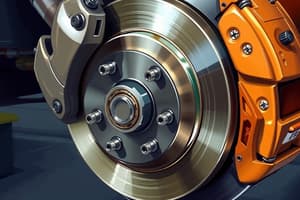Podcast
Questions and Answers
What is the primary reason for changing brake fluid every 2-3 years?
What is the primary reason for changing brake fluid every 2-3 years?
- To prevent corrosion caused by water absorption (correct)
- To maintain a consistent brake fluid level
- To improve brake performance
- To reduce the boiling point of brake fluid
What is the purpose of the small reservoir used in the one-person method?
What is the purpose of the small reservoir used in the one-person method?
- To pump the brake pedal
- To add new brake fluid to the system
- To close the bleeder valve
- To catch the old brake fluid (correct)
Why is it important to ensure the brake fluid level is checked regularly?
Why is it important to ensure the brake fluid level is checked regularly?
- To maintain a consistent brake fluid level
- To improve brake performance
- To prevent corrosion caused by water absorption
- To prevent air pockets in the system (correct)
What is the correct order for bleeding brakes using the one-person method?
What is the correct order for bleeding brakes using the one-person method?
What is the primary advantage of the one-person method over the two-person method?
What is the primary advantage of the one-person method over the two-person method?
What is the primary goal of changing the brake fluid?
What is the primary goal of changing the brake fluid?
How much new fluid is required to fill the system?
How much new fluid is required to fill the system?
What is the expected duration of the repair before needing another flush?
What is the expected duration of the repair before needing another flush?
What is the consequence of not changing the brake fluid?
What is the consequence of not changing the brake fluid?
What is the correct order for checking the brake calipers?
What is the correct order for checking the brake calipers?
Flashcards are hidden until you start studying
Study Notes
• ChrisFix is demonstrating how to bleed brake fluid from a 2001 Mazda B3000 Ford Ranger.
• Brake fluid should be changed every 2-3 years due to water absorption, which can cause corrosion and affect brake performance.
• Water has a low boiling point (212°F), which can cause brake fluid to vaporize and create air pockets in the system.
• ChrisFix is using a new brake fluid and will demonstrate how to bleed the system properly.
• There are two methods to bleed brakes: the two-person method and the one-person method.
• The two-person method involves one person pumping the brake pedal while the other person opens and closes the bleeder valve.
• ChrisFix is using the one-person method, which requires a special tool and a small reservoir to catch the old brake fluid.
• The process involves attaching the tool to the brake caliper and slowly releasing the old brake fluid while adding new fluid to the system.
• ChrisFix emphasizes the importance of not allowing air to enter the system and ensuring that the brake fluid level is checked regularly.
• The process is repeated for each brake caliper, starting from the rear passenger side and moving to the front.
• ChrisFix demonstrates how to use the one-person method on the rear passenger brake caliper.
• The process involves attaching the tool to the brake caliper, opening the bleeder valve, and slowly releasing the old brake fluid while adding new fluid to the system.
• ChrisFix emphasizes the importance of not allowing air to enter the system and ensuring that the brake fluid level is checked regularly.
• The process is repeated for each brake caliper, starting from the rear passenger side and moving to the front.
• ChrisFix demonstrates how to check for air in the system by pumping the brake pedal and checking for any signs of air bubbles.
• The process is completed when the brake fluid is clean and free of air bubbles.
• ChrisFix emphasizes the importance of regular brake fluid maintenance to ensure safe and reliable brake performance.- The brake fluid is contaminated and needs to be replaced to avoid further damage.
- The brake fluid is dirty and has metal shavings, which can cause problems if not changed.
- The brake caliper has a hole, which allows dirt and contaminants to enter and affect the brake system.
- The brake fluid level is low and needs to be refilled with new fluid to ensure proper brake function.
- The goal is to remove all contaminated fluid and replace it with new fluid to prevent further damage.
- The process involves draining the old fluid, cleaning the system, and refilling with new fluid.
- The new fluid is approximately 1.5 liters or 32 ounces, which is enough to fill the system.
- The repair is expected to last for 2-3 years before needing another flush.
- The video aims to provide a step-by-step guide on how to change brake fluid and clean the system.
Studying That Suits You
Use AI to generate personalized quizzes and flashcards to suit your learning preferences.




